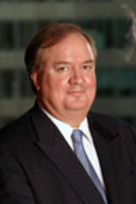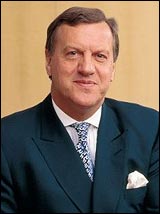Even though his appetite is temporarily sated from two key acquisitions in recent years, the leader of SCOR says the M&A “dancing floor will be open” across the reinsurance industry going forward.
Executive Summary
Reinsurance executives speaking at the Standard & Poor’s Insurance Conference discuss M&A activity, the influx of third-party capital and competition within the traditional reinsurance market, predicting a soft reinsurance market will last a few more years.“Anyone who tells you they’re not interested is lying,” Denis Kessler, chair and chief executive officer of SCOR, said during a panel of reinsurance CEOs at the Standard & Poor’s 30th annual Insurance Conference, indicating SCOR’s continued interest in mergers and acquisitions.
Joking that he won’t tango with fellow panelist John Charman, chair and CEO of Endurance Specialty Holdings, who is dancing already—a reference to Endurance’s bid to take over Aspen Insurance Holdings—Kessler went on to say that the need for economies of scale will be one of the drivers of future merger and acquisition activity in the reinsurance sector.
“To operate in this modern world, fixed costs are on the rise. You have to buy databases, you have to pay modelers.” Add to that compliance and regulatory costs, and the price tag balloons for companies seeking to do business globally. “There is a cost to being around the world,” he said.

Kessler, who would be inducted into the International Insurance Society’s Insurance Hall of Fame a few weeks after the June S&P conference, noted that his company recently acquired Transamerica Re (on the life side in a deal completed in 2011) and Generali U.S. (also a life reinsurance deal in 2013).
“It is better to play the game than to be waiting for someone to come to you,” he said. Later, he also suggested that reinsurers might engage in M&A to maximize potential diversification benefits of Solvency II.
Kessler’s comments followed an S&P tally of an audience poll of executives and analysts attending the session on the question of whether 2014 will be an active year for reinsurer M&A. Forty-one percent responded that they believe there will be one or two deals, 51 percent said three to five deals, and only 8 percent speculated that more than five deals will happen.
“Apparently, there are two different views in the industry about M&A, and mine is a positive one,” said Endurance’s Charman. “I believe the best use of excess capital should really be to deploy it strategically,” he said.

Charman continued: “At this stage of the market cycle, there are unique opportunities to create bigger, stronger, more relevant global insurance and reinsurance businesses [that are] much better prepared and much more able to withstand the competitive pressures we’re going to face in the future and to be able to deliver the profitability that shareholders require.”
“I am horrified that people think single-digit returns on equity are acceptable in a risk industry like ours.”
“So my view is I’d rather deploy capital in a strategic way to actually grow my business, at probably the worst possible time, and be well prepared for a change in the marketplace on both sides of the balance sheet—the underwriting side as well as the asset side.”
Constantine Iordanou, chair and CEO of Arch Capital Group, said he believes consolidation will be beneficial for the reinsurance industry, but he outlined three obstacles to deals: social issues, strategic issues and cultural issues.
Looking back through history, he recalled that in the 1970s, 80s and 90s, there were probably 150 reinsurers worldwide. “You had these pro-rata contracts that were two pages long and everyone was taking 1, 2 or 5 percent of the risk,” he said. So the consolidation that happened in the late 90s “helped the business,” he concluded.
But with about 30 major reinsurers worldwide today, Iordanou says even “further consolidation will improve the environment” for reinsurers and customers.
Going on to describe each of the obstacles, he said first that boards and senior executives of target companies will stall deals. “Nobody wants to give up the big fat paycheck to be on the board or to be a senior executive because it makes sense for shareholders.”
“Sometimes there is no strategic rationale because they may be incompatible businesses,” he added. “You need compatibility in order to gain the benefits of convergence.”
Turning to the third issue, Iordanou said: “Every company has a culture, and you shouldn’t allow yourself for consolidation purposes” to damage it. “To be bigger doesn’t always mean better if the culture is not compatible. If you have a certain underwriting culture and you mix it with a totally different underwriting culture, you are looking for a disaster,” he said.
While Iordanou did not specifically reference the bid for Aspen by Charman’s Endurance, some of his comments seemed to describe snags in that deal. Aspen said it viewed the potential combination as a strategic and cultural mismatch.
Third-Party Capital = Third-Party Litigants?
The reinsurance CEO panel discussion, moderated by S&P Director Taoufik Gharib, started predictably with a debate about the influx of alternative capital into the reinsurance market. During that discussion, Charman led off with his concerns about sidecars fueling competition without specifically referencing Watford Re, a sidecar-like facility for which Iordanou’s Arch Capital is performing underwriting services.
Highbridge Principal Strategies, a subsidiary of J.P. Morgan, is managing the investments of Watford, which is unique on the reinsurance underwriting side in its emphasis on long-tail casualty business.
Speaking generally about third-party capital from pension funds and hedge funds, Charman led off the session, saying: “My view is that it has not only created a much more competitive aspect than historically we would have expected throughout a normal cycle, but it also has changed underwriters’ behavior—because the companies that attach sidecars to their underwriting businesses essentially need to fill those buckets.”
“I’m afraid that need to fill those buckets in order to get the ceding commissions that are being offered [and] the profit commissions has actually created an extra momentum to the competitive pressure that would normally be created within the industry.”
“It’s not only the competition that third-party capital directly put[s] into the market. It’s also the indirect competition,” Charman concluded.
Iordanou said he agreed. He contrasted the property-catastrophe reinsurance sidecars that started up in 2006—including a $1.2 billion facility called Flatiron, launched by Arch at the time—with today’s sidecars.
“In those days, that sort of capital had a temporary presence in the business. A lot of investors wanted to come in when there was a need for additional capital in that particular sector, with the understanding that when that was not necessary, they would exit.”
“Some of those sidecars operated for two, three years, and then they disbanded,” Arch’s CEO said.
“The new influx of capital now has more permanence because the investors are looking to invest in the new capital, if they find the right underwriting facilities, for the longer term,” he said, explaining why they can now start digging into long-tail lines, where the books won’t be closed in two or three years.
“The exit is more difficult; it takes much longer. That understanding is there with the investors,” he asserted.
Returning to Charman’s point, he agreed that an excess supply of capital is causing pressure on reinsurance pricing. “But it’s not unusual. In our business, the capital supply goes up and down, and that’s what defines the cyclicality of the business,” he said.
Kessler’s assessment: “We don’t care. We invest in ILS [insurance-linked securities]. We issue ILS. And we transform and we help clients to issue ILS.”
Noting that the bulk of activity in the ILS market is focused on U.S. property-cat business, he reported that this segment makes up only 2 percent of SCOR’s book. “So we will survive this phenomenon,” he said, adding that SCOR also benefits from lower-priced retrocessional protection it places in through the ILS market.
Later, when Gharib asked whether third-party capital is behaving rationally with respect to pricing and how Florida renewals would play out at June 1, Iordanou said he gets frustrated with analysts who overemphasize the impact of third-party capital and focus discussions on the property-cat market. “We write $4 billion of gross revenue. Our property cat is less than $200 million. So it’s 5 percent of our portfolio,” he said.
On the other hand, there may be an effect on the rest of the business, he conceded. Predicting price drops of 10-15 percent in Florida at June 1, he said an unfortunate residual effect is that good underwriters will withdraw capacity in the face of new capital coming into the property market. “They’re going to deploy that [withdrawn] capital into something else, and that will have the pricing effect on that something else. Then that creates an environment that puts rates under pressure,” he said.
Charman said, “It’s strong and healthy competition that we’re facing. But at the end of the day, it’s largely model-driven competition. For those of us who have been around longer than five minutes, we’ve all seen that there’s a fundamental divergence [among] modeled output when you actually get beyond one-in-25 years to the reality of events occurring.”
He said his biggest concern is that in the event of a major loss, resulting litigation from third-party capital providers would “harm the [traditional reinsurance] industry—become reflected back on the industry.”
“The industry historically has responded extremely well to its cedents and its clients in the event of major losses. And it will be a test of the marketplace this time around when we actually do have another major loss as to how these different factions will respond.”
“Lawyers will be the big beneficiaries of the ILS movement,” Kessler added, contrasting a world of litigation on one side with the reinsurance world of cooperation and arbitration.
Re Market Softness: Two or Three More Years
On the pricing front, Iordanou contrasted the primary and reinsurance markets, noting that Arch participates in both. On the primary side, “you have seen at least three years of consecutive price increases, price on price. Even though that may be slowing down [to] 4 or 5 percent, it’s still above loss trend. So in essence, the underlying business is improving.”
Given this is the case, “cedents say, ‘My book of business is good. It’s improving in profitability, and I want to keep it. If you (the reinsurer) want a piece of it, you have to pay for it”—by increasing ceding commissions on pro-rata business (3-5 points), dropping rates significantly or expanding terms on excess-of-loss business.
This creates a “frenzy of competition,” he said, “and in my 38 years in the business, it usually doesn’t end very well. One person’s little aggression becomes the next person’s bigger aggression, and all of a sudden you have the softening that we have experienced in the last year-and-a-half in the reinsurance market.”
“There’s no indication yet for prices stabilizing. There are more requests from the brokers on excess-of-loss [treaties] for lower reinsurance rates; there are more requests for additional ceding commissions [on pro-rata]. And some facilities are too willing to provide that.
“So I think the prospect for the next two or three years is to be for a soft reinsurance marketplace.”
In Europe, Kessler reported that while an individual account might experience a 20 or 30 percent rate dip, overall SCOR’s Jan. 1 renewals came in at minus 2.4 percent.
“That’s an erosion. It’s not a fall. It’s not a collapse,” Kessler said, noting that the rate level still allows the reinsurer to meet profit hurdles.
At April 1, rates for Japan dropped back to those in effect before the Tohoku earthquake. “We didn’t go below,” Kessler said. “That means the reinsurance market is still profitable” in Japan.
While Iordanou focused on “the asymmetry” between the primary and reinsurance markets, Charman said that he foresees a bifurcation between businesses “with relevance” and those without it in both sectors. Specifically, he contrasted companies that “are on top of their business activity, their risk selection, their underwriting capability, their technical ability, [and] their ability to obtain the diversity and the scale from whatever activity is out in the marketplace” and companies that “just supply the market with capacity.”
“They have very little relevance in a soft marketplace. They’re caught between a rock and a hard place. The markets will bifurcate, and those people are going to get left behind very quickly. Their financials will begin to show it. They add no capability. They add no value to the market.”
Kessler gave a similar assessment, adding a middle level of quality, size and diversification and referring to Tier 1, Tier 2 and Tier 3 reinsurers. “If you’re in Tier 3, you can buy a T-shirt with ‘no future'” written across the front, Kessler said, echoing Charman’s remarks about relevance.
Gharib pressed Charman about whether the industry had learned its lesson from past cycles, and Endurance’s CEO responded by highlighting “a fundamental change” in the market at the turn of century, with participants now much more aware of their risk exposures.
Still, “a cycle is a cycle,” he concluded. “This is my fourth aggressive cycle,” he said. “When you think that the cycle should be bottoming out, people tend to panic, even in good underwriting businesses. Then you find an increased level of competition, which is completely illogical and irrational even by good underwriting businesses. That’s when you know you’re coming to the end.
“But that’s normally around for another year or two,” he said.
“I look regrettably at the softness of the market prevailing absent a major loss for another two to three years,” he predicted.





















 Berkshire Hathaway Announces Leadership Appointments: New CEO at GEICO
Berkshire Hathaway Announces Leadership Appointments: New CEO at GEICO  Rebuilding Negotiation Talent: Why This Skill Is Missing and How to Fix It
Rebuilding Negotiation Talent: Why This Skill Is Missing and How to Fix It  Why Insurance Telematics Integrations Fail
Why Insurance Telematics Integrations Fail  Legal Finance and Insurance: From Confusion to Collaboration
Legal Finance and Insurance: From Confusion to Collaboration 






















